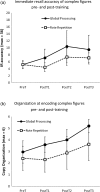Global processing training to improve visuospatial memory deficits after right-brain stroke
- PMID: 23070314
- PMCID: PMC3589919
- DOI: 10.1093/arclin/acs089
Global processing training to improve visuospatial memory deficits after right-brain stroke
Abstract
Visuospatial stimuli are normally perceived from the global structure to local details. A right-brain stroke often disrupts this perceptual organization, resulting in piecemeal encoding and thus poor visuospatial memory. Using a randomized controlled design, the present study examined whether promoting the global-to-local encoding improves retrieval accuracy in right-brain-damaged stroke survivors with visuospatial memory deficits. Eleven participants received a single session of the Global Processing Training (global-to-local encoding) or the Rote Repetition Training (no encoding strategy) to learn the Rey-Osterrieth Complex Figure. The result demonstrated that the Global Processing Training significantly improved visuospatial memory deficits after a right-brain stroke. On the other hand, rote practice without a step-by-step guidance limited the degree of memory improvement. The treatment effect was observed both immediately after the training procedure and 24 h post-training. Overall, the present findings are consistent with the long-standing principle in cognitive rehabilitation that an effective treatment is based on specific training aimed at improving specific neurocognitive deficits. Importantly, visuospatial memory deficits after a right-brain stroke may improve with treatments that promote global processing at encoding.
Figures






Similar articles
-
Perceptual organization and visual immediate memory in children with specific language impairment.J Int Neuropsychol Soc. 2006 Jul;12(4):465-74. doi: 10.1017/s1355617706060607. J Int Neuropsychol Soc. 2006. PMID: 16981598 Free PMC article.
-
Organizational strategy influence on visual memory performance after stroke: cortical/subcortical and left/right hemisphere contrasts.Arch Phys Med Rehabil. 2000 Jan;81(1):89-94. doi: 10.1016/s0003-9993(00)90227-2. Arch Phys Med Rehabil. 2000. PMID: 10638882
-
[Attention and executive processes in neuropsychological rehabilitation of the visuospatial processes].Rev Neurol. 2004 Mar 1-15;38(5):487-95. Rev Neurol. 2004. PMID: 15029530 Review. Spanish.
-
Set shifting and visuospatial organization deficits in body dysmorphic disorder.Psychiatry Res. 2018 Feb;260:182-186. doi: 10.1016/j.psychres.2017.11.062. Epub 2017 Nov 24. Psychiatry Res. 2018. PMID: 29202381
-
The Effects of Computer Based Cognitive Rehabilitation in Stroke Patients with Working Memory Impairment: A Systematic Review.J Stroke Cerebrovasc Dis. 2020 Dec;29(12):105265. doi: 10.1016/j.jstrokecerebrovasdis.2020.105265. Epub 2020 Sep 11. J Stroke Cerebrovasc Dis. 2020. PMID: 32992171
Cited by
-
The Altered Reconfiguration Pattern of Brain Modular Architecture Regulates Cognitive Function in Cerebral Small Vessel Disease.Front Neurol. 2019 Apr 5;10:324. doi: 10.3389/fneur.2019.00324. eCollection 2019. Front Neurol. 2019. PMID: 31024423 Free PMC article.
-
Assessment of neglect dyslexia with functional reading materials.Top Stroke Rehabil. 2014 Jan-Feb;21(1):75-86. doi: 10.1310/tsr2101-75. Top Stroke Rehabil. 2014. PMID: 24521842 Free PMC article.
-
Disrupted topological organization of resting-state functional brain networks in cerebral small vessel disease.Hum Brain Mapp. 2022 Jun 1;43(8):2607-2620. doi: 10.1002/hbm.25808. Epub 2022 Feb 15. Hum Brain Mapp. 2022. PMID: 35166416 Free PMC article.
-
Interventions for people with perceptual disorders after stroke: the PIONEER scoping review, Cochrane systematic review and priority setting project.Health Technol Assess. 2024 Oct;28(69):1-141. doi: 10.3310/WGJT3471. Health Technol Assess. 2024. PMID: 39485540 Free PMC article.
-
Interventions for perceptual disorders following stroke.Cochrane Database Syst Rev. 2022 Nov 3;11(11):CD007039. doi: 10.1002/14651858.CD007039.pub3. Cochrane Database Syst Rev. 2022. PMID: 36326118 Free PMC article.
References
-
- Akshoomoff N. A., Feroleto C. C., Doyle R. E., Stiles J. The impact of early unilateral brain injury on perceptual organization and visual memory. Neuropsychologia. 2002;40(5):539–561. doi:10.1016/s0028-3932(01)00129-4. - DOI - PubMed
-
- Barrett A. M., Beversdorf D. Q., Crucian G. P., Heilman K. M. Neglect after right hemisphere stroke—A smaller floodlight for distributed attention. Neurology. 1998;51(4):972–978. - PubMed
-
- Binder L. M. Constructional strategies on complex figure drawings after unilateral brain damage. Journal of Clinical Neuropsychology. 1982;4(1):51–58. - PubMed
-
- Bliokas V. V., Taylor J. E., Leung J., Deane F. P. Neuropsychological assessment of fitness to drive following acquired cognitive impairment. Brain Injury. 2011;25(5):471–487. doi:10.3109/02699052.2011.559609. - DOI - PubMed
-
- Bornstein R. F., Dagostino P. R. Stimulus-recognition and the mere exposure effect. Journal of Personality and Social Psychology. 1992;63(4):545–552. - PubMed
Publication types
MeSH terms
Grants and funding
LinkOut - more resources
Full Text Sources
Medical

